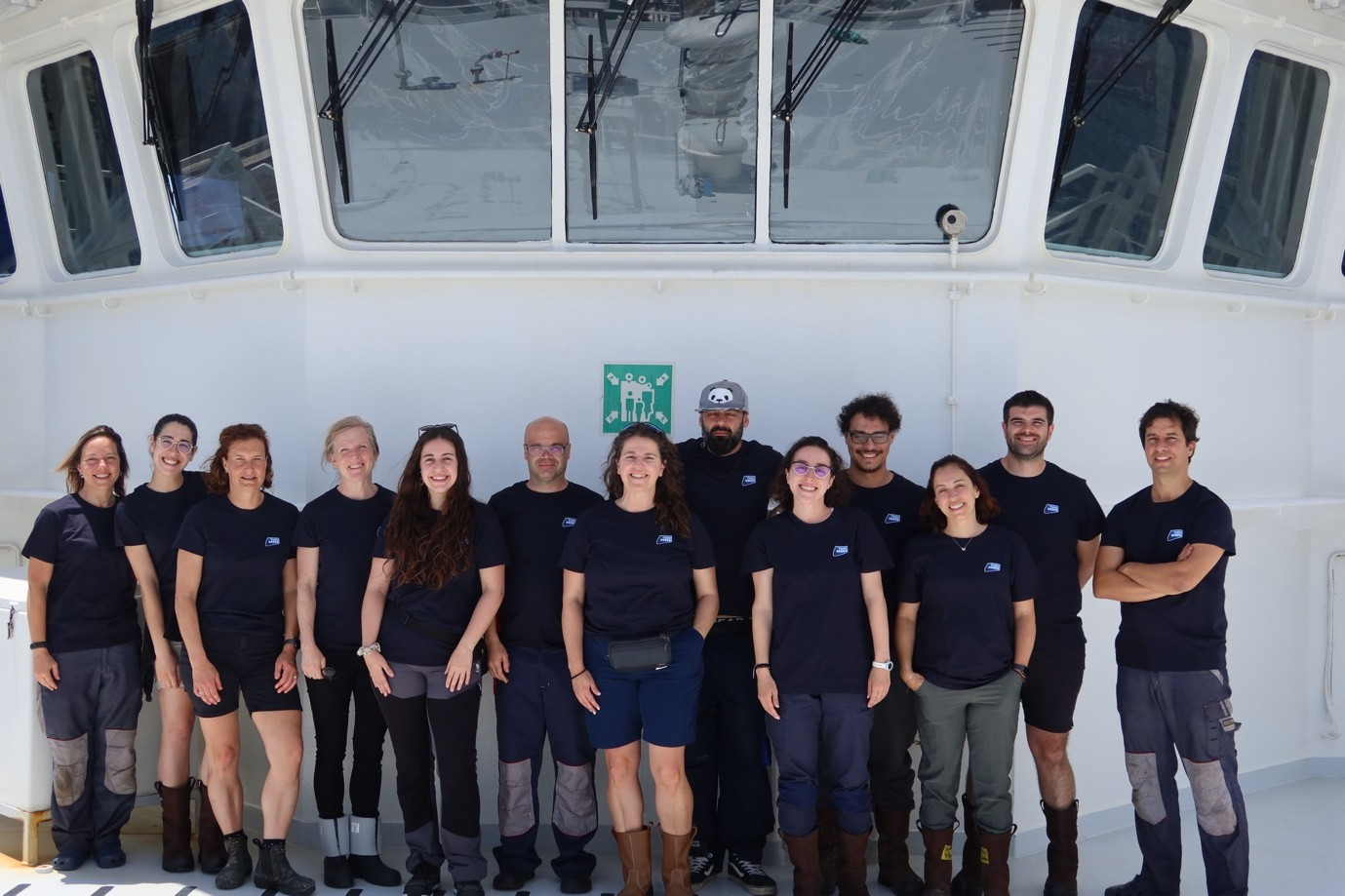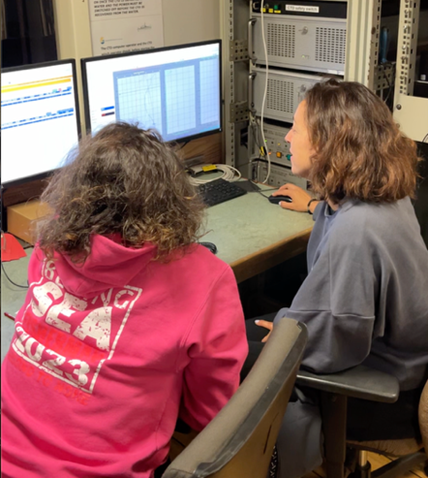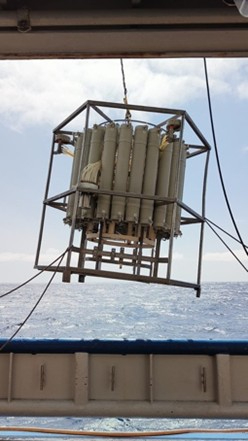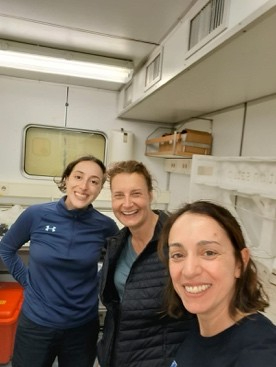You can find out more about our work onboard on the next posts and about the project on our webpage. Follow us on LinkedIn and Bluesky to stay tuned as we advance knowledge on largest biome of the planet – the deep ocean!

“Under pressure: The Gorringe Bank’s Tale of Trash, Contaminants, and Totally Stressed Scientists"
Long days of travel can be demanding, especially for a scientist not used to life at sea. For a novice sailor, the first extended voyage on the ocean brings its own challenges - seasickness being among the most difficult. The body struggles as the inner ear rebels against the vessel’s unpredictable motion. After all, we were made to walk on a brown dirty road and not on the blue crystal water.
Finally, we arrive at the Gettysburg Seamount, in the Gorringe Bank. Around us stretches an unbroken horizon; no land, no other vessels - just us and the sea. It feels we are utterly alone in this isolated domain.
The Gorringe Bank, an underwater mountain range in the Atlantic Ocean, is a vital refuge for marine biodiversity, sustaining unique ecosystems. Yet, as we continue studying this environment, a question emerges: can such an isolated region truly remain untouched by human influence?
The answer, sadly, is as clear as the crystalline water beneath our ship. Exploration of the seabed using ROV Luso and a towed camera reveals the truth. Scattered across the depths are distressing signs of human

For an environment so seemingly untouched, the impact of human behavior is unmistakable. The journey to the Gorringe Bank underscores a harsh reality: even the most remote corners of the Earth bear the marks of our presence and are sensitive to human-induced environmental changes.
During our travels, we encountered multiple challenges with the ROV dive, especially navigating and dodging through numerous long fishing lines found along our exploration path. The constant risk of entanglement heightened our stress during these missions.
Beyond the physical concerns raised, one of the most pressing concerns and one of the goals of this mission was to study the presence of polycyclic aromatic hydrocarbons (PAHs), contaminants of emerging concern (CECs), and heavy metals. PAHs, derived from fossil fuel combustion and industrial discharges, persist in sediments and bioaccumulate, disrupting marine food webs. CECs and heavy metals, including microplastics and pharmaceuticals, harm marine species and might induce environmental disturbances. Monitoring these pollutants at the Gorringe Bank is essential to assess ecological impacts and guide conservation efforts and might serve as a benchmark for understanding contaminant spread across ocean basins, enhancing predictive models for their movement and impact. These insights contribute to global marine conservation efforts, ensuring the protection of critical habitats and the vital services they provide to humanity.
Not only is the seamount impacted by human activity, but the scientists aboard the ship also changed during the journey. Colleagues, so far seen in the institute corridors, and new people are now living and working with each other, 24/7 for two weeks. Stressed, overwhelmed, with few hours of sleep. Colleagues are now friends and after all, everything was worth it. What next? Now we are waiting for a new opportunity to uncover as much as about the deep sea as we currently know about the moon that graced the sky at the moment this text was written!
(Un)Familiar faces during a deep-sea campaign.
Every day, humans tend to attribute to any shape the silhouette of animals, cartoons, etc. The shape of an animal in a cloud or even in a car front are examples of what our imagination is capable. In our campaign it wasn’t different. During our ROV dives and box cores, and while discovering what inhabits the seafloor of the Gettysburg seamount in the Gorringe bank, we gave wings to the imagination and we found some of these familiar faces, in unfamiliar places. From bears to moray eels (well, we know that we should expect such face at sea but take a look below!), and even Pingu (the cartoon), we spotted some interesting shapes in the deep-sea rocks of the area that reminds us that nature can be artistic, and we, even that not on purpose, too!

But is it just for fun that we look at faces? Of course not! While doing the different operations and observations during the campaign, for example, ROV dives or observation of marine mammals and seabirds, the face of the animals is a key feature to identify species. For example, while observing seabirds we spotted two different shearwaters, the Great shearwater (Ardenna gravis) and the Cory’s shearwater (Calonectris borealis). These are very similar seabirds but with a major difference in the colour of their head. The Great shearwater has a black-cap while the Cory’s shearwater has a brown-grey-ish colour on its head that reaches the neck. On ROV dives, the shape of the “face” can help us in the identification of species, for example grenadiers (fish from Macrouridae family) have a triangular shape when looking from above (though the easiest way to identify these fish is from their tail which ends in a thin rat-like tail) but also the boar fish (Capros aper) who has a very conical face or the Frogmouth/Coffinfish (Chaunax sp.) which has a face that looks it is always grumpy are examples of species that looking to the face of animals (colour, shape, or event attributing facial expressions that we usually use for humans) we are able to identify them and better understand the biodiversity of the Gorringe Bank.

CTD measurements and water filtration
After a few days of transit, leaving from Las Palmas, we finally arrived at the Seamount of the Gorringe Bank on the 6th of June. One of the first things we did was the launching of the CTD (Conductivity, Temperature and Density) sensor and a water collector, the Rosette. From the operations control room, we accompanied the descent of the CTD and Rosette to the deep-sea, and, at the same time, the first readings of the physical and chemical parameters of the water were being sent to the operations room computers.

We were really excited when the first Rosette came out of the sea, carrying about 144 Litres of water from over 2000m deep. What a responsibility! Because this is not just water...this water contains valuable information regarding the biodiversity inhabiting this deep-sea environment, lying in its tiny particles. To detangle this information, we immediately started to recover the water from the rosette and filtered it, with the aim of collecting these particles and concentrate all the environmental DNA from this water.

The analysis of this DNA will allow us to uncover a little bit more about the biodiversity of this beautiful seamount. Hopefully, these findings will support the establishment of efficient conservation measures that will permit the survival of this very special ecosystem for many decades to come.
